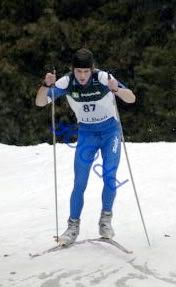 by Harald » Thu Feb 09, 2006 6:10 pm
by Harald » Thu Feb 09, 2006 6:10 pm
I do not understand this preoccupation with seeing rising in transition. I don?t use extension to release in any of my turns. I don?t teach extending (nor do we in PMTS) for any turns, yet there seems to be hysteria about HH rising.
The intent of what you are doing is the important part of how movements take effect. If you, as I explained in anther post, flex or bend by 1mm you are on the right track, if you extend by 1mm you are on the wrong track if you are a habitual push off skier.
Regardless of what you see, skiers who bend to release may show the body moving toward the new turn with what looks like rising to the untrained eye. I have explained this before. If you take a ski pole and tilt it up hill, leave the tip of the pole in the same place in the snow, then bring the handle straight down through and to the falline until the ski pole is tilted downhill, did the ski pole extend or did it stay the same length? Of course it stayed the same length. Does it look like it extended at the point when it was perpendicular to the falling, of course it did. Many PSIA trained skiers or instructors can't differenciate between a push-off and a flexing transition!!!
The ski pole did not make an extension move. When I ski at low amplitude, like I often do in my videos, I demonstrate movements of flexing and retracting of the old stance leg and foot for a PM and I continue to flex it during transition.
If the inside leg is not flexed or angled to any great degree, due to speed and slope, especially at slow speed, (when it is not necessary) the transition might look like the CG goes up, (as the leg stays close to the same length especially if you only flex by 1mm, but it isn?t being pushed up (same as the ski pole). This is a strong distinction to be understood.
If you want to see up movements that are incorrect watch the Sogard and Weems video. They both use an up and an extension, this is very different form how I ski and how we teach in PMTS. If you watch the bump skiing sections of my videos where I am skiing naturaly at my normal speed you will see definate retraction.
This is why I don?t agree with instructors who say, ?Good skiing is good skiing?. That demonstrates poor MA capability. There maybe a category of skiing called good for ?PSIA Skiing? but don?t confuse that with ?Good PMTS? skiing, they are different.
When I teach the Super Phantom, I make sure the inside leg stays flexed at the end of the turn (when balance is transfered to it) and that is stays flexed through the transition. Because the inside leg has to hold and stabilize the upper body over the boot or foot and the core has to stabilize the body from rotating and leaning, some transitions look like the CG moves over to the little toe edge. This is correct and OK for learning little toe edge balance.
Once more hill dynamics are added to the Super Phantom turn, the time spent where the CG is over the little toe edge is miniscule, so the CG no longer looks like it moves up to the little toe edge. There is absolutely nothing wrong with teaching that the CG moves over to the little toe edge for the Super Phantom, this is an exercise for skiers who do not know how to exit a turn without stemming. The Super Phantom is the wedge blocker. It is an exercise, not a technique or a movement. I find that instructors confuse movements with exercises and exercises with technique and technique with movements.
You can incorporate the S-Phantom into your skiing and make it completely fluid.
"Maximum Skiing information, Minimum BS


